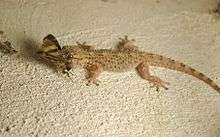Tarentola mauritanica
Tarentola mauritanica, known as the common wall gecko, is a species of gecko (Gekkota) native to the western Mediterranean area of Northwestern Africa and Europe and widely introduced to America and Asia. It is commonly observed on walls in urban environments, mainly in warm coastal areas. However, it can be found further inland, especially in Spain. A robust species, up to 150 millimetres long, its tubercules are enlarged and give the species a spiny armoured appearance.[2] It is a nocturnal animal with a predominantly insectivorous diet.
| Tarentola mauritanica | |
|---|---|
 | |
| Scientific classification | |
| Kingdom: | Animalia |
| Phylum: | Chordata |
| Class: | Reptilia |
| Order: | Squamata |
| Family: | Phyllodactylidae |
| Genus: | Tarentola |
| Species: | T. mauritanica |
| Binomial name | |
| Tarentola mauritanica | |
The species was first described by Carl Linnaeus in 1758.[3] It is also known as moorish gecko, crocodile gecko, European common gecko, and, regionally, as salamanquesa (in Spanish), osga (in Portuguese) and dragonet (in Catalan).
Description
Adults can measure up to 15 cm, tail included. Robust body and flat head. Back, legs and tail with prominent conic tubercles. Its regenerated tail is smoother and doesn't have tubercles. Obtuse mouth, big eyes with no eyelids and vertical pupil. Fingers with big lateral growths and adherent division less laminae in the bottom face. Only the third and fourth fingers end in union. Brownish grey or brown coloration with darker or lighter spots. These colours change in intensity according to the light. When they are active by day their colour is darker than during the night. It can be found on many construction sites, ruins, rock fields, tree trunks, etc.
Biology
Mainly nocturnal or crepuscular. Also active during the day, on sunny days at the end of the winter especially. They like to receive sunlight near their refuge. They hunt insects and in the warmer months of the year it can be found hunting nocturnal insects near light sources, street lamps, etc. They lay 2 almost-spherical eggs twice a year around April and June. After 4 months, little salamanquesas of less than 5 cm in length are born. Moorish geckos are slow to mature, taking 4 to 5 years in captivity.
The introduction of the species may impact on native fauna, by preying on frogs and smaller lizards. The adoption of this species as a pet has led to populations becoming established in Florida and elsewhere.[2]
It is the host of Haemoproteus tarentolae, a protozoan species in the genus Haemoproteus, and Esther's gecko mite (Geckobia estherae), endemic to Malta.
Image gallery
%2C_Cala_de_Mijas%2C_Spain.jpg) Tarentola mauritanica, Spain
Tarentola mauritanica, Spain Tarentola mauritanica from the region of Montpellier
Tarentola mauritanica from the region of Montpellier- Tarentola mauritanica, Portugal
 Individual recently hatched
Individual recently hatched
See also
- Lists
- other
References
| Wikimedia Commons has media related to Tarentola mauritanica. |
| Wikispecies has information related to Tarentola mauritanica |
- Vogrin, M., Corti, C., Pérez Mellado, V., Baha El Din, S. & Martínez-Solano, I. 2017. Tarentola mauritanica. The IUCN Red List of Threatened Species 2017: e.T61578A63716927. https://doi.org/10.2305/IUCN.UK.2017-2.RLTS.T61578A63716927.en. Downloaded on 08 February 2019.
- "Common Wall Gecko". Geckoweb. Finding Species. Retrieved 2009-01-27.
- "Tarentola mauritanica (Linnaeus, 1758)". Integrated Taxonomic Information System.
